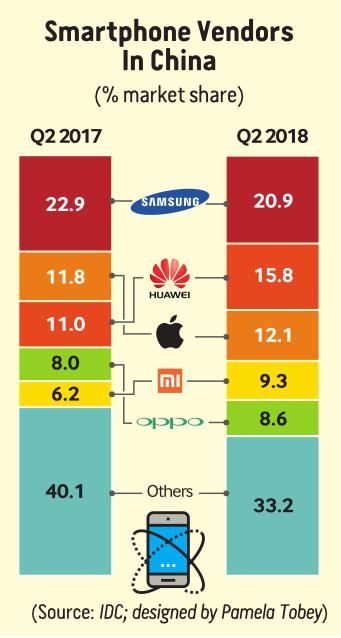Growing Smarter
2018-10-21ByMichaelZakkour
By Michael Zakkour


For the first time since 2010, Apple wasnt one of the top two in number of smartphones shipped globally. Chinas Huawei beat it out, shipping 54.2 million handsets in the second quarter, while Apple shipped 41.3 million during the same period. Samsung remained the number one shipper with 71.5 million units and rounding out the top four was Chinas Xiaomi with 31.9 million phones shipped.
These numbers were reported by U.S.-based consulting and research firm International Data Corp. It said that Huawei also surpassed Apple in total market share with 15.8 percent compared to 12.1 percent for Apple. Samsung is still the global market share leader with 20.9 percent, while Xiaomi is fourth with 9.3 percent.
Of course, the total number of units shipped and global market share do not tell the whole story of the rise of Chinas device makers, from both positive and negative perspectives. However, it does mark a watershed moment in which they have the chance to be considered global market leaders and technology innovators, in much the same way Japanese electronics companies evolved from cheap alternatives to industry standard setters in the 1970s to the 1990s.
There are various elements that should be examined in depth to better understand the current rise and the future of Chinese smartphone makers.
Chinese mobile living
Perhaps more than any other population on earth, Chinese citizens live their lives inside of their mobile devices. Over the past 10 years, a perfect storm of factors has made the mobile handset the primary life tool in China.
The first was the lack of a high-penetration modern landline system to replace and overcome the old system as China grew wealthier. Even as late as 2003, there were only 42 phones for every 100 people. When the first smartphones were introduced, many Chinese people skipped over landlines and went directly to mobile phones.
The second was the introduction of e-commerce. Lacking a modern retail infrastructure, and once assured that digital commerce was safe, reliable and adapted for life in China, citizens jumped on board in huge numbers.
Finally, when digital payments went from escrow services and limited early applications to advanced, easy-to-use and ubiquitous services, the perfect storm created a population that could do virtually anything on their phones.
These three factors—and the nature of Chinese life as social and communityoriented—drove mobile penetration rates to unprecedented levels and made it the number one market in the world.
In 2006, for the fi rst time, more than 100 million smartphones were sold in China and only a year later consumers snapped up 190 million units. Today there are more than 1.2 billion handsets being used in the country. But for a long time, the industry was dominated by foreign brands like Nokia, Apple, Samsung and Sony.
By cleverly investing in research and development and innovative new technologies, and by understanding the features and price points that appealed to the local market, Chinese brands are now as strong in China as their much older and established foreign counterparts. Chinese people can do things on their mobile phones that people in other markets can only dream of.
This has created a successful “network effect,” whereby the more features that brands add, the more users they attract; and the more users they attract, the more valuable the technology and network become.
Advanced features
Huaweis recent gains in market share and units shipped can largely be attributed to the appeal of its Honor line of phones. Introduced in 2013, the android-powered phone was a big step forward for Chinesemade smartphones. The business model of selling on its own e-commerce sites and through third-party sites was a smart and cost-saving way to reach a mass audience, along with the unit itself combining smart features with an affordable price. The Huawei P20 has also been a major hit for the company.
Great tech, indeed: The Huawei P20 Pro handset boasts three rear-facing cameras, including one with 40 megapixels and augmented and virtual reality features. The company debuted the Honor 6X at the Consumer Electronics Show in Las Vegas in January 2017, and it won several Best of Show awards. The Honor 7S is available in the United States for $99 and the Honor 10 for $540.
Xiaomi, which built its reputation on providing cool features for bargain prices, has also advanced signifi cantly in the last couple of years. It offers a wide array of phones to meet every budget and level of desired sophistication.
However, as with many products, what is cool and cutting edge today can become a commodity tomorrow. Chinese smartphone makers need to start—and in some cases continue—to provide services as well as hardware if they are to ensure their future growth and profi tability.
This is especially true as mobile handset penetration rates reach critical mass in China. There simply arent enough new customers and not enough demand for yearly or bi-yearly upgrades to sustain growth. Not to mention that heavy competition has led to lower prices and lower margins for domestic makers.
Xiaomi has taken the lead in expanding into services. As reported by TechCrunch in August, “70 percent of Xiaomis revenue comes from smartphones, 20 percent comes from connected devices and lifestyle products, and 10 percent comes from Internet services.” Smartphones are Xiaomis customer acquisition tool for its Internet services. And over time, Xiaomis Internet service revenue will grow more rapidly than most people think.
As of March, Xiaomi already had 38 apps with more than 10 million monthly active users, and 18 apps with more than 50 million monthly active users including the Mi App Store, Mi Browser, Mi Music and Mi Video apps. Rather than paying search engines to acquire users, Xiaomi is essentially getting paid for acquiring users by selling its smartphones. This allows Xiaomi to have a negative customer acquisition cost for its Internet services.
This is a model that is well established in the United States. Apple started as a device maker, but its services, app store, cloud computing and other businesses make the company stick and very profitable. Google started as a service company that added devices and operating systems to augment its search and advertising businesses.
Chinese makers need to continue expanding into services and alternative products to follow Apple and Googles lead globally. It would make sense for them to further integrate into the massive New Retail ecosystems being built by Alibaba, JD.com and Tencent.
Going Global
In all likelihood, there will be more than 5.5 billion Internet users worldwide by 2030, up from 3.5 billion today, with as many as 700 million connecting in the next fi ve years.
Chinese smartphone companies must still act and serve locally while acting and serving in a global market. As stated earlier, Huawei shipped 54 million handsets in the second quarter of the year, but only 4 million of those were shipped outside of China. This is impressive but leaves a long runway for growth.
There are three key global growth opportunities for Chinese smartphone makers:
Developing markets. The vast majority of new Internet users will start their online lives with a smartphone. The days of newcomers connecting via PC or laptop are gone. The vast majority—as much as 80 percent of them—will come from emerging markets including India, Indonesia and the countries of sub-Saharan Africa and Latin America and the Caribbean. The Chinese device titans have already entered and created footholds in these markets. Rapid expansion with the dual device/services model is an open road to growth.
Developed markets. While offering services may be a longer-term goal in North America and Europe, Chinese companies, especially Huawei, can build on the increasing acceptance of “designed, made and branded in China” in the consumer electronics arena.
Growth in China and Chinese-speaking consumers. In the same way that Chinas e-commerce and New Retail giants are working to connect hundreds of millions of rural people, Chinas device makers have the opportunity to offer devices and services at price points that will encourage fi rst purchases and also encourage affordable and frequent upgrades. There is also the opportunity to sell to what I call the China global consumer demographic. There are hundreds of millions of ethnic Chinese and Chinesespeaking consumers the world over. This presents a unique category of consumers that have not been fully addressed to date.
The perfect storm of life lived through devices, e-commerce and hundreds of millions of newly connecting global consumers provides Chinese device makers an unprecedented opportunity.
If they can ensure trust and acceptance from consumers and governing institutions globally, continue to invest in innovation and new services, and differentiate themselves from more experienced and globally known brands, then certainly, one glowing screen at a time, their future will brighten. n
